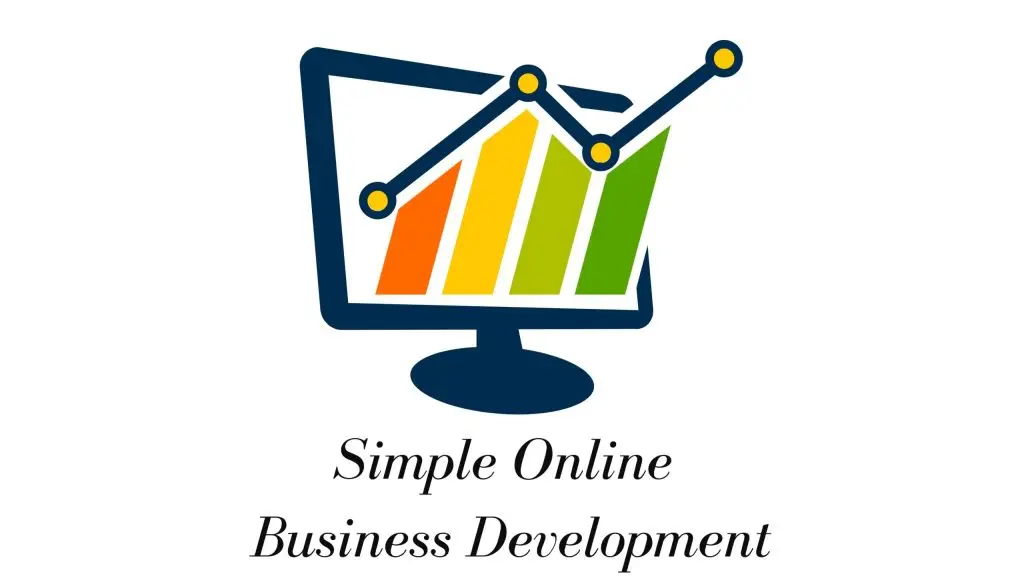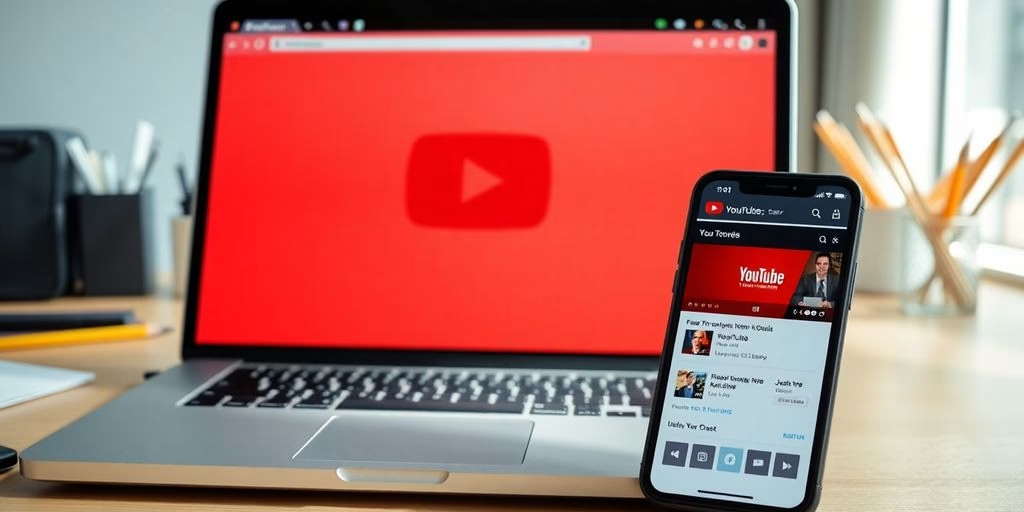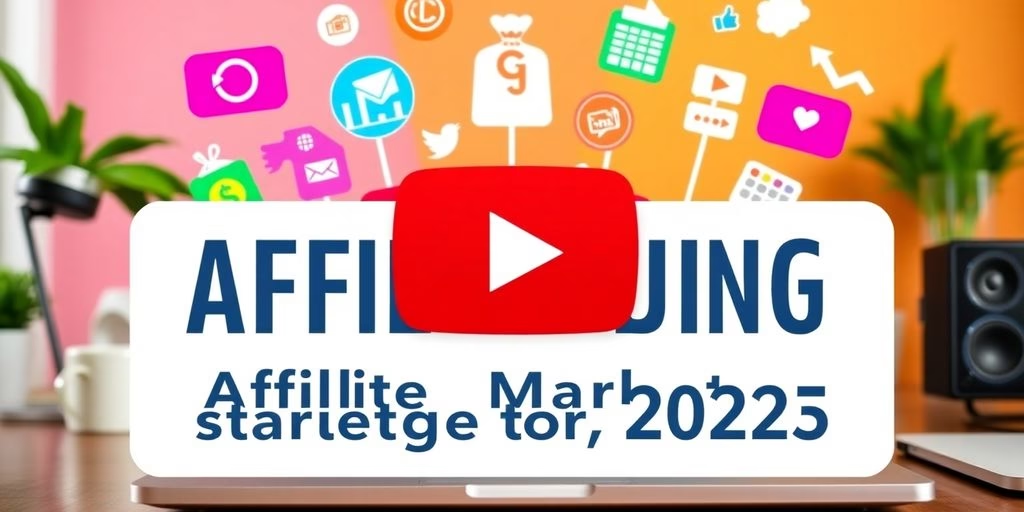Creating a YouTube business account can be a game changer for your brand. With video content gaining more traction than ever, having a dedicated channel helps you connect with your audience, showcase your products, and build trust. This guide breaks down the steps on how to create a YouTube business account, ensuring you set up your channel for success right from the start.
Key Takeaways
- A YouTube business account enhances brand visibility and trust.
- Video marketing is essential for engaging with customers effectively.
- Setting up a Google account is the first step to creating your YouTube channel.
- YouTube Studio is your main hub for managing your channel and content.
- Regularly analyze your channel’s performance to improve your strategy.
Understanding The Benefits Of A YouTube Business Account
Alright, let’s talk about why you should even bother with a YouTube business account. It’s not just about uploading videos; it’s about building a real presence and making some serious waves. Trust me, it’s worth it!
Why Video Marketing Matters
Okay, so why video? Well, everyone’s watching videos these days. Think about it: how many times have you scrolled through social media and stopped to watch a quick clip? Exactly! Video marketing is super engaging, and it’s a fantastic way to grab attention in a world that’s constantly bombarded with information. It’s not just about showing; it’s about connecting. Plus, YouTube is the second largest search engine, so people are actively looking for video content. It’s a goldmine!
Building Brand Awareness
Think of your YouTube channel as your brand’s digital storefront. It’s a place where people can get to know you, your products, and your story. The more consistent and engaging your content, the more recognizable your brand becomes. It’s like planting seeds; the more you nurture your channel, the more your brand awareness grows. And hey, who doesn’t want to be a household name? You can also use YouTube to promote your Google My Business listings.
Engaging With Your Audience
YouTube isn’t just a one-way street; it’s a conversation. It’s a place where you can interact with your audience, respond to comments, and build a community. Think of it as your own personal focus group, where you can get real-time feedback and build relationships with your viewers. Plus, the more engaged your audience, the more likely they are to become loyal customers. It’s a win-win! Here are some ways to engage:
- Respond to comments promptly.
- Ask questions in your videos to encourage interaction.
- Run polls and Q&A sessions.
Creating a YouTube business account is like opening a new door to opportunity. It’s a chance to connect with a massive audience, build your brand, and drive sales. So, what are you waiting for? Let’s get started!
Getting Started With Your Google Account
Alright, let’s dive into setting up the backbone of your YouTube business channel: your Google account. It’s simpler than you might think, and we’ll walk through it together. Think of this as your digital key to unlocking all the awesome features YouTube has to offer for businesses.
Creating A New Google Account
Don’t have a Google account yet? No sweat! It’s super easy to create one. Just head over to the Google Account creation page and follow the prompts. You’ll need to provide some basic info like your name, a username, and a password. Make sure to choose a strong password – you know, the kind that’s hard to guess. Once you’ve filled everything out, you’ll be ready to roll.
Using An Existing Account
Already have a Google account? Awesome! You’re one step ahead. You can totally use your existing account for your YouTube business channel. Just make sure you’re logged in before you start setting things up. It’s all about convenience, right? You can keep your personal and business stuff separate later on, but for now, let’s get you logged in and ready to go.
Setting Up Your Profile
Okay, whether you created a new account or are using an existing one, let’s make sure your profile is looking good. This is your chance to make a first impression, so let’s make it count.
- Add a profile picture: Choose something professional or representative of your brand.
- Fill out your "About Me" section: Tell people a little about yourself or your business.
- Double-check your contact info: Make sure it’s accurate so people can reach you.
Having a complete and professional-looking profile builds trust and credibility with your audience. It shows that you’re serious about your channel and your business.
Now, let’s move on to the fun part: creating your actual YouTube business channel!
Navigating YouTube Studio Like A Pro
Okay, so you’ve got your YouTube business channel all set up – awesome! Now, it’s time to get comfy with YouTube Studio. Think of it as your channel’s mission control. It might seem a little overwhelming at first, but trust me, once you get the hang of it, you’ll be flying through it like a pro. Let’s break it down.
Accessing YouTube Studio
Getting into YouTube Studio is super easy. Just head to YouTube and click on your profile picture in the top right corner. A dropdown menu will appear, and YouTube Studio will be one of the options. Click it, and boom, you’re in! It’s your central hub for managing everything related to your channel.
Understanding The Dashboard
Alright, you’re in the dashboard. What now? The dashboard gives you a quick overview of what’s happening with your channel. You’ll see things like your latest video performance, recent subscriber activity, and news from YouTube. It’s a great way to get a snapshot of your channel’s health at a glance. Don’t worry too much about every single metric right away; focus on the big picture.
Exploring Key Features
YouTube Studio is packed with features, so let’s highlight a few of the most important ones:
- Content: This is where all your videos live. You can see their status (public, private, etc.), views, comments, and more. It’s also where you’ll upload new videos.
- Analytics: This section is gold! It gives you tons of data about your audience, video performance, and channel growth. We’ll analyze your channel’s performance later, but get familiar with this area.
- Comments: Here, you can manage and respond to comments on your videos. Engaging with your audience is key, so make sure to check this regularly.
- Subtitles: Adding subtitles makes your videos accessible to a wider audience. YouTube Studio makes it pretty straightforward to add and edit them.
- Customization: This is where you can tweak your channel’s appearance, like adding a channel trailer or organizing your videos into playlists. Make sure your channel looks professional with a great channel banner image.
YouTube Studio is your friend. Don’t be afraid to click around and explore. The more you use it, the more comfortable you’ll become, and the better you’ll be at managing your channel for success.
Creating Your YouTube Business Channel
Alright, so you’ve got your Google account all set up and you’re ready to roll. Now comes the fun part: actually creating your YouTube business channel! It’s not as scary as it sounds, trust me. Let’s break it down.
Choosing A Channel Name
This is a big one, folks. Your channel name is like your digital handshake. It’s the first thing people see, so you want to make a good impression. Ideally, you’ll want to use your business name. Makes sense, right? But hey, if your business name is already taken, or if you’re going for something a little more creative, that’s cool too. Just make sure it’s something memorable, easy to spell, and relevant to the kind of content you’ll be putting out. For example, if you are creating videos for online courses, you might want to include the course name in the channel name.
Setting Up Your Channel
Okay, name in mind? Great! Now, head over to YouTube Studio. You can find it by clicking on your profile picture in the top right corner and selecting "YouTube Studio" from the dropdown menu. Once you’re there, look for the "Create a Channel" option. It might be hiding in the settings somewhere, but don’t worry, it’s there. Click on it, and YouTube will walk you through the steps. You’ll need to confirm your brand name and agree to YouTube’s terms. It’s pretty straightforward, just follow the prompts.
Linking Your Business Website
This is a step you definitely don’t want to skip. Linking your business website to your YouTube channel is like giving viewers a direct line to your products or services. It’s a fantastic way to drive traffic and potentially convert viewers into customers. To do this, go to the "Customization" tab in YouTube Studio, then click on "Basic Info." Scroll down, and you’ll see a section for "Links." Add your website URL there, and boom! You’ve just made it easier for people to learn more about your business. Think of it as a digital business card, but way cooler. This is especially important if you are trying to create a video commercial for your business.
Customizing Your Channel For Maximum Impact
Alright, so you’ve got the basics down, now it’s time to make your YouTube channel shine. Think of this as decorating your store – you want it to be inviting, on-brand, and memorable. A well-customized channel not only looks professional but also helps viewers understand what you’re all about at a glance. Let’s get into the nitty-gritty of making your channel pop!
Designing Your Channel Art
Your channel art, also known as a banner image, is the first thing people see when they land on your page. It’s prime real estate for showcasing your brand’s personality and value proposition. Make sure it’s visually appealing and communicates what your channel is about. I’ve seen some channels update their banner image periodically to reflect things like sales or events. It keeps things fresh! YouTube will give you a preview of each image to show you how it will be displayed on multiple devices, so you can make changes as needed.
Adding A Profile Picture
Your profile picture is what people will see next to your videos and comments, so it’s important to choose something recognizable. Usually, a logo works best, but a clear headshot can also do the trick if you’re the face of your brand. Make sure it’s high-resolution and scales well, so it looks good no matter where it’s displayed. It’s a small detail, but it makes a big difference in terms of branding.
Creating A Compelling Channel Description
Your channel description is your chance to tell viewers what your channel is all about. Keep it concise, engaging, and keyword-rich. What kind of content do you create? What can viewers expect to gain from subscribing? Include a call to action, encouraging people to subscribe or check out your website. Think of it as your elevator pitch – you want to hook people in and make them want to learn more. You can also choose to link to other platforms from your YouTube channel. For example, you could link to your other social media accounts, your store’s website, or your blog. All of those links will appear as part of your YouTube profile. Most of your profile links will default to showing the platform name and favicon (the small image—often a brand logo—that shows up at the top of your browser when you visit a site). However, the first link in the lineup will also show the link title, so that’s prime real estate for customizing your own call to action (CTA) to drive online store traffic.
Don’t underestimate the power of a well-crafted channel description. It’s your chance to make a first impression and convince viewers that your channel is worth their time. Make it count!
Here are some things to include in your channel description:
- A brief overview of your channel’s content
- A clear value proposition for viewers
- A call to action encouraging subscriptions
Uploading Your First Video With Confidence

Alright, you’ve got your channel all set up, looking snazzy, and you’re itching to share your brilliance with the world. Uploading that first video can feel like a big step, but trust me, it’s easier than you think! Let’s break it down so you can quickly generate sales and get your content out there.
Choosing The Right Video Format
First things first, let’s talk format. YouTube loves certain video formats more than others. MP4 is generally your best bet – it’s widely compatible and offers good quality without massive file sizes. MOV is another option, especially if you’re on a Mac. But honestly, stick with MP4 unless you have a really good reason not to. It’ll save you headaches down the road. Also, consider your aspect ratio. Widescreen (16:9) is the standard for YouTube, so make sure your video is formatted that way to avoid weird black bars.
Editing Tips For Beginners
Okay, so you’ve shot your video, and now it’s time to make it shine. You don’t need to be a pro editor to create something watchable. Here are a few simple tips:
- Cut the Fluff: Be ruthless! Trim out any dead air, long pauses, or rambling bits. Keep it concise and engaging.
- Add Music (But Be Careful): A little background music can make a big difference, but make sure you have the rights to use it! YouTube’s copyright system is no joke. There are plenty of royalty-free music sites out there.
- Use Transitions Sparingly: Simple cuts are often better than fancy transitions, especially when you’re starting out. Overdoing it can look amateurish.
- Pay Attention to Audio: Good audio is way more important than perfect video. Make sure your voice is clear and easy to hear. Use a decent microphone if you can.
Remember, the goal is to create something that people will actually want to watch. Don’t get bogged down in perfectionism. Just focus on delivering good content in a clear and engaging way.
Optimizing Video Titles And Descriptions
Alright, you’ve got your video looking and sounding great. Now, let’s make sure people can actually find it! This is where optimization comes in. Your title and description are super important for YouTube’s algorithm.
- Title: Keep it short, sweet, and to the point. Include relevant keywords that people are likely to search for. But don’t just stuff it with keywords – make it sound natural and appealing.
- Description: This is your chance to tell YouTube (and viewers) what your video is all about. Write a detailed description that includes relevant keywords, a summary of the video’s content, and a call to action (e.g., "Subscribe for more!").
- Tags: Use relevant tags to help YouTube understand your video’s topic. Think about what people would search for to find your video.
Here’s a quick example:
| Element | Example |
|---|---|
| Title | "How to Bake the Perfect Chocolate Chip Cookies" |
| Description | "In this video, I’ll show you how to bake delicious chocolate chip cookies from scratch. Get the full recipe and tips for perfect cookies every time!" |
| Tags | "chocolate chip cookies", "baking recipe", "cookie recipe", "dessert" |
With these tips, you’ll be well on your way to uploading your first video with confidence. Good luck, and happy creating!
Promoting Your Channel Effectively
Okay, so you’ve got your YouTube business channel all set up and you’re uploading videos. Awesome! But now what? It’s time to get those videos seen! Promotion is key to growing your channel and reaching a wider audience. Think of it like this: you’ve built a fantastic store, but nobody knows it exists. Let’s change that!
Utilizing Social Media
Don’t let your YouTube channel exist in a bubble. Cross-promote your videos on all your other social media platforms. I’m talking Facebook, Instagram, TikTok, even LinkedIn if it fits your brand. Share snippets, behind-the-scenes content, or host a live stream to announce new uploads. Think of it as creating a web that leads back to your YouTube channel. It’s all about making it super easy for people to find and watch your stuff. For example, you can create engaging TikTok videos for business to drive traffic to your YouTube channel.
Collaborating With Other Creators
Team up with other YouTubers! Seriously, it’s a game-changer. Find creators whose content complements yours, and brainstorm some fun video ideas together. This is a great way to tap into a whole new audience. When choosing collaborators, consider:
- Audience alignment: Do their viewers match your target demographic?
- Content style: Will your audiences enjoy the collaboration?
- Growth potential: Can this collaboration lead to long-term benefits?
Upload videos on both channels and use call-to-actions to direct viewers to each other’s pages. It’s like a virtual high-five that benefits everyone involved.
Engaging With Your Audience
Don’t just upload and run! Talk to your viewers. Respond to comments, ask questions, and create polls. The more you interact, the more loyal your audience will become. Community is a powerful tool on YouTube. Give people a reason to stick around and become invested in your channel. For example, if you’re posting a video on how to schedule social media content, ask people to comment and share which platforms they use. This interaction boosts your videos in the YouTube algorithm and creates a community around your brand channel.
Remember, building a successful YouTube channel is a marathon, not a sprint. Stay consistent, keep creating great content, and engage with your audience. You’ve got this!
Analyzing Your Channel’s Performance
Alright, you’ve poured your heart and soul into creating awesome content for your YouTube business channel. Now, let’s see if all that hard work is paying off! This is where analytics come in. Don’t worry, it’s not as scary as it sounds. Think of it as peeking behind the curtain to see what’s working and what’s not. Ready to dive in?
Understanding YouTube Analytics
YouTube Analytics is your new best friend. It’s like a treasure map, guiding you to understand how your channel is performing. You can find it in YouTube Studio on the left menu. Seriously, spend some time poking around in there. You’ll see all sorts of cool stuff, like:
- Views: How many times your videos have been watched.
- Watch Time: The total amount of time people have spent watching your videos.
- Subscribers: How many people have subscribed to your channel.
- Impressions: How many times your thumbnails were shown to viewers.
Looking at these metrics over time can show you trends. Are your views going up? Are people sticking around to watch your whole video? This data is super useful for figuring out if your YouTube strategy is actually working.
Tracking Viewer Engagement
Okay, so you know how many views you’re getting, but are people actually engaged with your content? That’s the real question. Here’s what to look at:
- Average View Duration: How long people watch your videos on average. A low number might mean people are clicking away quickly.
- Audience Retention: This shows you exactly when people are dropping off in your videos. Super helpful for figuring out which parts are boring or confusing.
- Likes and Comments: Are people reacting to your videos? Are they asking questions or sharing their thoughts? This is a great way to gauge interest and build a community.
Adjusting Your Strategy Based On Data
So, you’ve got all this data… now what? Time to put it to good use! The whole point of analyzing your channel is to make smarter decisions about your content. Here’s how:
- Double Down on What Works: If you see that certain types of videos are performing really well, make more of them!
- Tweak What Doesn’t: If a video has low audience retention, figure out why. Was the intro too long? Was the audio bad? Learn from your mistakes and improve.
- Experiment: Don’t be afraid to try new things! Use your analytics to see if your experiments are paying off. Maybe try different online marketing tools to promote your videos.
By paying attention to your analytics and adjusting your strategy accordingly, you’ll be well on your way to YouTube success!
Wrapping It Up
So there you have it! Creating a YouTube business account is totally doable, and honestly, it can be a game changer for your brand. Just follow those steps, and you’ll be on your way to sharing your awesome content with the world. Remember, it might take some time to get the hang of things, but don’t sweat it! Keep experimenting, stay consistent, and most importantly, have fun with it. Your audience is out there waiting to connect with you, so get started today!
Frequently Asked Questions
What is the purpose of a YouTube business account?
A YouTube business account helps you promote your brand through videos, connect with customers, and build trust.
Do I need a Google account to create a YouTube business account?
Yes, you must have a Google account to set up a YouTube business account.
How can I customize my YouTube channel?
You can customize your channel by adding a profile picture, banner, and description that reflects your brand.
What type of videos should I upload to my business channel?
You should upload videos that showcase your products, share tutorials, or provide valuable information that interests your audience.
How can I promote my YouTube channel?
You can promote your channel by sharing your videos on social media, collaborating with other creators, and engaging with your audience.
What tools can I use to analyze my YouTube channel’s performance?
YouTube Analytics is a built-in tool that helps you track views, engagement, and other important metrics for your channel.








































